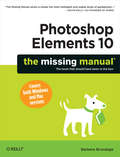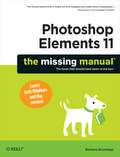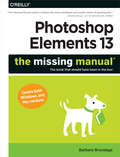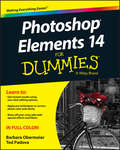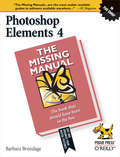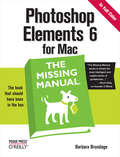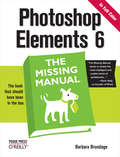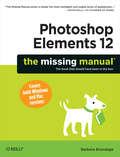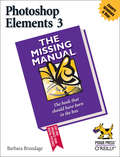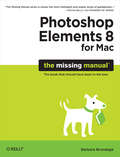- Table View
- List View
Photoshop Elements 10: The Missing Manual
by Barbara BrundageElements 10 offers much of Photoshop's power without the huge price tag. It's a great tool for most image-editing buffs—whether you’re a photographer, scrapbooker, or aspiring graphic artist. But Elements still doesn't come with a useful manual. This bestselling book helps you get the most out of the program, from the basics to advanced tips for both Windows and Mac users.The important stuff you need to know:Quickly learn your way around. Customize Elements to suit your working style.Get to work right away. Import, organize, and make quick image fixes with ease.Retouch any image. Learn how to repair and restore old and damaged photos.Add pizzazz. Give images more zip with dozens of filters, layer styles, and special effects.Design with words. Make text flow along a curved path or around an object or shape.Find your creative flair. Create scrapbooks, greeting cards, photo books, and more.Try out advanced techniques. Work with layers, blend modes, and other tools.
Photoshop Elements 11 For Dummies
by Ted Padova Barbara ObermeierBetter photos are a breeze with the latest version of Photoshop Elements and Dummies Amateur photographers and photo enthusiasts turn to Photoshop Elements for a powerful but simpler way to edit and retouch their snapshots. Photoshop Elements 11 For Dummies is the perfect guide for helping every shutterbug add a touch of creativity to their images. Learn how to find your way around the Elements interface and its new features; create, edit, fix, and organize your photos; add type and interesting effects to your images; and share them with the world. Full color pages bring the techniques to life and make taking great photos fun and easy. Introduces you to the tools, menus, options, and work area Shows you how to import and upload images Reviews ways to view, find, organize, and manage your photos Details how to modify your photos to your specifications Distills working with layers, contrast, color, clarity, filter, effects, styles, and type Explains how to print your creations, create a slide show, and optimize images for the web Whatever you want your images to be, the sky's the limit with Photoshop Elements 11 For Dummies close at hand.
Photoshop Elements 11: The Missing Manual
by Barbara BrundageWhether you’re a photographer, scrapbooker, or aspiring graphic artist, Photoshop Elements is an ideal image-editing tool—once you know your way around. This bestselling book removes the guesswork. With candid, jargon-free advice and step-by-step guidance, you’ll get the most out of Elements for everything from sharing and touching-up photos to fun print and online projects.The important stuff you need to know:Get to work right away. Import, organize, and make quick fixes with ease.Retouch any image. Repair and restore old and damaged photos.Add pizzazz. Use dozens of filters, layer styles, and special effects.Share photos. Create online albums, email-ready slideshows, and web-ready files.Find your artistic flair. Use tools to draw, paint, work with blend modes, and more.Use your words. Make text flow along a curved path or around an object or shape.Unleash your creativity. Design photo books, greeting cards, calendars, and collages.Make yourself comfortable. Customize Elements to fit your working style.
Photoshop Elements 13 All-in-One For Dummies
by Ted Padova Barbara ObermeierMake ordinary photos extraordinary with Photoshop Elements 13 Whether you prefer to snap shots on your smartphone or never leave home without your DSLR, chances are you have way more photos than you ever dreamed possible. With the help of Photoshop Elements 13 All-in-One For Dummies, you can edit those photos and turn them into stunning works of art. The book will help you get to know the key features of Photoshop Elements, including examining the Elements workspace; navigating the tools; viewing images on your computer; setting your preferences; and acquiring, saving, and exporting images. You'll then take your skills to next level and become a pro at working with iOS and Android devices, specifying resolution and changing image sizing, choosing color modes and file formats, working with Camera Raw, using and managing color, painting and drawing with Elements, creating layers, and so much more. Plus, you'll discover how to add pizzazz with styles and effects, apply quick image makeovers, correct lighting, color, and clarity, and composite with Photomerge. Photoshop Elements is the #1-selling consumer photo editing software, and Adobe continues to add innovative features that allow digital photography enthusiasts to do it all. Going well beyond the basics of how to use Photoshop Elements—and weighing in at more than 672 pages—Photoshop Elements 13 All-in-One For Dummies is the most comprehensive Elements book on the market. Written by Barbara Obermeier and Ted Padova, veteran authors, long-time instructors, and expert speakers who have spent decades specializing in digital imaging, this hands-on, friendly guide is jam-packed with everything you need to create, edit, fix, share, and organize digital images. Combines nine content-rich books in one value-packed reference Includes updated and revised information to reflect the latest release, Photoshop Elements 13 Richly illustrated in full color and brimming with easy-to-follow, step-by-step instructions Explains how to enhance your images by adjusting color, brightness, resolution, contrast, and sharpness Whether you're an amateur photographer or new to the digital photo scene and want to perform sophisticated editing techniques with a powerful image-editing software program, Photoshop Elements 13 All-in-One For Dummies has everything you need—and more.
Photoshop Elements 13 For Dummies
by Ted Padova Barbara ObermeierTake your photos from "meh" to "wow!" with Photoshop Elements 13 and this expert guide Photoshop Elements 13 For Dummies is your guide to picture perfection using Adobe's Photoshop Elements. This full-color manual walks you through the process of photo editing, from basic color corrections to advanced filter effects, drawing, and more. Work through from beginning to end for a complete lesson, or keep it handy as a quick reference for unfamiliar tools and techniques. Designed for beginner and intermediate Photoshop Elements users, this book provides straightforward instruction in a fun, richly illustrated, easy-to-read style that makes learning feel like play. Combining powerful tools with a user-friendly interface has made Photoshop Elements the number-one selling photo editing software. Photoshop Elements 13 For Dummies shows you how to take advantage of everything the software has to offer, helping you create high-quality images for print, e-mail, and the web. Even with no digital image editing experience at all, you'll learn how to take your photos from bland to beautiful and have a blast along the way. Adjust resolutions, color modes, and file formats to best suit the project Work with layers, filters, effects, styles, type, and more Correct color, contrast and clarity for a simple photo makeover Optimize for print, or share on Facebook, Flickr, and other social networks The power and simplicity of Photoshop Elements makes it the perfect solution for amateurs seeking an affordable digital editing platform. The quicker you learn the tools, the sooner you'll be turning out photos to brag about – and Photoshop Elements 13 For Dummies will get you there in a flash.
Photoshop Elements 13: The Missing Manual
by Barbara BrundagePhotoshop Elements 13 looks sharper, performs better, and has more sophisticated photo-editing and slideshow features than previous versions—but knowing which tools to use when can be confusing. The new edition of this bestselling book removes the guesswork. With candid, jargon-free advice and step-by-step guidance, you’ll get the most out of Elements for everything from sharing and touching-up photos to fun print and online projects.The important stuff you need to know:Get to work right away. Import, organize, edit, crop, and color-correct your photos with ease.Retouch any image. Repair and restore old and damaged photos, and patch undesirable areas with Content-Aware Fill.Add pizzazz. Dress up your photos with dozens of filters, layer styles, and special effects.Create the perfect picture. Seamlessly insert people and objects from other photos, using Photomerge Compose.Share your photos. Use new methods to quickly create and email stunning slideshows to friends.Use your words. Make greeting cards, calendars, and flyers by adding text to images.Unleash your creativity. Design photo books, scrapbooks, collages, and other projects.
Photoshop Elements 14 For Dummies
by Ted Padova Barbara ObermeierThe bestselling book on Photoshop Elements—now in a new edition Getting great photos is easier than you think—it just takes some know-how and a tool like Adobe's Photoshop Elements. Photoshop Elements 14 For Dummies is a fun and easy-to-follow guide for photographers and photo enthusiasts who want to make their snapshots picture perfect. In no time, you'll tackle the basics of Photoshop Elements and find out how to execute hundreds of tasks, like using special effects and drawing tools, working with layers, improving your color and clarity, and so much more. Photoshop Elements is the #1 selling consumer photo editing software, and Adobe continues to add innovative features that allow professional and self-made digital photographers to do it all. Written by veteran authors Barb Obermeier and Ted Padova, this full-color guide shows you how to make the most of the latest version of the software in a fun and friendly way that makes learning feel like play. Even if you have no digital image editing experience at all, this hands-on guide shows you how to take your photos from 'meh' to 'wow'—and have a blast along the way! Get instant results using one-click editing options Apply pro techniques to correct photo color and clarity Show off your artsy side with special effects and filters Find tips for improving edits and creative projects The power and simplicity of Photoshop Elements makes it easy to turn out photos worth bragging about—and this no-nonsense guide will get you there in a flash.
Photoshop Elements 2018 For Dummies
by Ted Padova Barbara ObermeierThe top-selling book on Photoshop Elements—updated in a new edition Photoshop Elements offers photo editors of all skill levels the power to turn run-of-the-mill images into beautiful works of art—and Photoshop Elements 2018 For Dummies shows you how. Those new to photo editing who are looking for advice on making the most common fixes and experienced editors in need of a road map to this version of Photoshop Elements will find great value in this book! Start off by touring the Photoshop Elements interface with introductions to the tools that make the program so powerful. You’ll also follow simple step-by-step instructions for organizing images for editing, creating layers in your images, adjusting color and focus, applying artsy filters, adding text to an image, and so much more. Get simple explanations for handling image editing Find steps for giving your photos a digital makeover Discover tips for getting better photos Create frame-worthy pieces you’ll be proud to display If you’re ready to take your photo editing skills to new heights, all the help you need is a page—and a click—away.
Photoshop Elements 2019 For Dummies
by Ted Padova Barbara ObermeierTurn blah photos into dazzling images Photoshop Elements offers enough of the power you’ll find in full Photoshop to make both basic and artistic edits to your photos. Photoshop Elements 2019 For Dummies helps you learn how to use Photoshop Elements to take your shots to stunning new heights! Photoshop Elements 2019 For Dummies offers photographers of all skill levels the power to turn run-of-the-mill digital pictures into beautiful photographs. This friendly and helpful guidebook directs you on how to harness all the tools this powerful software has to offer. Simple explanations for handling image editing Steps for giving your photos a digital makeover Ways to turn your photos into works of art Guidance on fixing your pics with one click No matter if you're a photo editing newcomer looking for advice on making the most common fixes or an experienced editor in need of a road map to this version of Photoshop Elements, this book has you covered!
Photoshop Elements 2020 For Dummies
by Ted Padova Barbara ObermeierGo beyond one-click filters with Photoshop Elements 2020 Photoshop Elements offers the tools to make quick, simple fixes to photos or to turn your images into completely different pieces of art. Digital imaging pros Barbara Obermeier and Ted Padova walk you step-by-step through the tools that help you take control of this powerful software. Discover simple one-click fixes that repair the most basic photo problems then dive into creative editing and adding artistic touches. You'll also find tips on shooting better photos and managing common photo projects. Apply instant edits to your digital images Improve lighting and add some color pops Discover artistic filters that push your creativity Create a frame-worthy print This fun guide is here to provide help to photographers and designers who prefer the latest version of the lighter, less-expensive version of Photoshop.
Photoshop Elements 2021 For Dummies
by Ted Padova Barbara ObermeierGet picture-perfect results with Photoshop Elements 2021 Photoshop Elements has a reputation for delivering the photo editing power that non-professional photographers and designers need to get eye-catching—and art-quality—results. This book offers guidance for applying everything from simple, one-click fixes all the way up to detailed retouching of your images. Photoshop Elements 2021 For Dummies assumes no prior photo-editing experience and makes it easy for even the absolute beginner to quickly grasp how to edit to create slick, professional-looking photos. In no time at all you’ll feel confident in everything from common image fixes to utilizing more creative techniques, such as using image layers to create a standout look. You’ll also find tips on building and managing complex photo projects. Understand photo-editing concepts Adjust clarity, color, and brightness Add artistic touches Catalog and organize your work This fun and easy guide provides the steps you need to get the most out of this popular version of Photoshop—and will help you achieve truly beautiful results!
Photoshop Elements 2022 For Dummies
by Ted Padova Barbara ObermeierMake your photos pop without any visual design or editing experience With cameras on every phone, we've all got more photos than we know what to do with. But what if you could optimize and beautify every snap you take, regardless of the lighting or background? What if you could turn every shot of your adorable baby or a serene sunset into a stunning work of art? Photoshop Elements 2022 For Dummies is the key to making that happen. This handy, step-by-step guide walks you through every aspect of using Photoshop Elements—the intuitive and accessible cousin of the more complex Photoshop—to make your next picture the best one you've ever taken. Don't have any graphic design experience? Don't worry! This handbook is written specifically for everyday, busy people who want to learn Photoshop Element's photo editing tools without wading through complicated jargon or confusing instructions. In no time flat, you'll be fixing red eye, enhancing contrast and colors, and adding artistic flair to photos people can't help but enjoy and share. Get a handle on the most basic Photoshop Elements features before moving on to more advanced walkthroughs that will have you editing like a pro Figure out how to build, manipulate, and alter layers so you can change one part of a picture without altering the whole thing Make tiny adjustments—like fixing glare—or fundamental changes—like switching backgrounds—with the click of a mouse So, get ready for more social media "Likes" than you know what to do with. You're about to turn your photos into something truly special.
Photoshop Elements 2023 For Dummies
by Ted Padova Barbara ObermeierTransform your images from ordinary to extraordinary in Photoshop Elements Great for non-professional photographers and designers, Adobe's Photoshop Elements is packed with all the photo editing tools you need to turn your images into showstoppers. And with the help of Photoshop Elements 2023 For Dummies, you'll discover the ins and outs of this affordable, beginner-friendly photo editing software. Learn all the tricks for simple, one-click fixes, before leaping into more advanced editing features. Work with layers, brighten colors, add filters, and make your images pop! Learn the basics of Photoshop Elements and quickly improve your photos Enhance color, boost contrast, and sharpen your images Get to know more advanced Photoshop tools like layers Create eye-catching images and improve your designsThis book is for you whether you&’re new to Photoshop Elements or an experienced user needing a refresh on the latest features. You&’re in good hands with Dummies.
Photoshop Elements 2024 For Dummies
by Ted Padova Barbara ObermeierGet in touch with your creative side using Photoshop Elements Photoshop Elements 2024 For Dummies covers the newest version of Adobe’s beginner-friendly photo editing software. With the help of this Dummies guide, you’ll discover the ins and outs of Photoshop Elements, so you can transform your images from ordinary to extraordinary. The software is packed with all the photo editing tools you need to turn your images into showstoppers. With the help of the easy-to-understand instructions in this book, you’ll learn how to use the editing tools, utilize layers, make one-click fixes, brighten colors, add filters, and beyond. Get started with Photoshop Elements and make basic edits in quick mode Create different views of an image and use the history panel to find the best version of your image Replace backgrounds, merge photos, and do other neat editing tricks Understand camera raw to turn your camera’s image data into a stunning photo This bestselling Dummies guide is the book you need to get started with Elements and learn the insider tips that will give your images that “wow factor.”
Photoshop Elements 2025 For Dummies
by Ted Padova Barbara ObermeierIgnite your creativity with Photoshop Elements Introducing the latest edition of Photoshop Elements 2025 For Dummies, updated for the newest version of Adobe's affordable and beginner-friendly photo editing software. With this comprehensive guide at your fingertips, you'll unlock the potential of Elements, turning ordinary photos into extraordinary images. Packed with all the essential photo editing tools, this software empowers you to brush up snapshots, create like-worthy social media posts, and create artistic masterpieces. In this easy-to-understand guide, you'll find instructions on using editing tools, working with layers, making one-click fixes, brightening colors, adding filters, and beyond. Master the basics of Photoshop Elements and make basic edits in Quick Mode Learn advanced editing techniques such as background replacement, stylize type, apply blend modes, social meda sharing, and other creative tricks, Discover the latest AI features such as depth of field, change object color, and combine photos Utilize camera raw to transform your camera's image data into stunning photographs Perfect for non-professional photographers and graphic designers new to Elements or looking for a refresh, this best-selling Dummies guide is your essential companion for getting started with Elements and learning insider tips to create images that “pop.”
Photoshop Elements 4: The Missing Manual
by Barbara BrundageThe popularity of digital cameras continues to grow exponentially. They are now more powerful, feature rich, and affordable--turning digital photography into a mainstream interest. And with Photoshop Elements, Adobe has created the most popular photo-editing program on the planet. Learning how to work Photoshop Elements and manage digital photos can be a challenge for anyone just getting started--from the hobbyist to the pro photographer. With the latest Photoshop Elements 4 update, Adobe delivers a powerful new program that provides photo editing and organizing functionality with improved performance. The updated version also includes new, more intuitive features that are streamlined and easier to use--when the photographer has the right learning tool in hand.With Photoshop Elements 4: The Missing Manual, author Barbara Brundage has written the perfect digital photography guide. In a clear, easy-to-read format, the author provides step-by-step instruction so readers can learn what they need to do to edit their photos successfully and manage their collection. This new edition also includes more than a dozen downloadable images so readers can practice using the editing tools. Readers will master useful editing techniques--from the most common to the advanced:Automatically correct red eye and skin tonesSelect and extract complex objects with the Magic Selection Brush and The Magic ExtractorCreate photomontagesRestore old photographsPost photos on the webManage and archive an entire collectionDesign a custom slide show with panning and zooming capabilitiesOnce photographers learn how to edit their photos successfully, they'll also learn how to post them online or upload them to the Kodak EasyShare Gallery for use in creating personal mailing lists, post cards, calendars, and much more. Photoshop Elements 4: The Missing Manual, is for any photographer interested in learning the right editing techniques for producing and sharing beautiful digital photography.Photoshop Elements 4: The Missing Manual covers the Windows version of the software only. When we published the book, there was no Mac version of the software (as there is now), and for various reasons, we've been unable to update this edition to include the Mac version. Nonetheless, if you're on a Mac, you can use this book. Just substitute Command for Ctrl, and Option for Alt whenever you see keystroke shortcuts, and about 98 percent of the Editor functions will work the same. The sections on the Organizer only apply to Windows because the Mac version has no Organizer.
Photoshop Elements 6 for Mac: The Missing Manual (Missing Manual)
by Barbara BrundageAfter more than two years, Adobe has finally released a new version of Photoshop Elements for the Mac. Version 6 packs a lot more editing firepower than iPhoto, and this Missing Manual puts every feature into a clear, easy-to-understand context -- something that no other book on Elements does! Photoshop Elements 6 is perfect for scrapbooking, making fancy photo collages, and creating Web galleries. It has lots of new features such as Guided Edit for performing basic editing tasks, an improved Photomerge feature, a handy Quick Selection Tool, and much more. But knowing what to do and when is tricky. Photoshop Elements 6 for Mac: The Missing Manual explains not only how the tools and commands work, but when to use them. With it, you will:Learn to import, organize, and fix photos quickly and easily.Repair and restore old and damaged photos, and retouch any image.Jazz up your pictures with dozens of filters, frames, and special effects.Learn which tools the pros use -- you'll finally understand how layers work!Create collages and photo layout pages for greeting cards and other projects.Get downloadable practice images and try new tricks right away.This full-color guide starts with the simplest functions and progresses to increasingly complex features of Elements. If you're ready for the more sophisticated tools, you can easily jump around to learn specific techniques. As always, author Barbara Brundage lets you know which Elements features work well, which don't, and why -- all with a bit of wit and humor. Don't hesitate: Now that Adobe's outstanding photo editor has been updated for the Mac, dive in with Photoshop Elements 6 for Mac: The Missing Manual right away.
Photoshop Elements 6: The Missing Manual
by Barbara BrundageWith Photoshop Elements 6, the most popular photo-editing program on Earth just keeps getting better. It's perfect for scrapbooking, email-ready slideshows, Web galleries, you name it. But knowing what to do and when is tricky. That's why our Missing Manual is the bestselling book on the topic. This fully revised guide explains not only how the tools and commands work, but when to use them.Photoshop Elements 6 is packed with new features. You get a new Quick Edit function, Windows Vista compatibility, improved RAW conversion, a handy Quick Selection Tool, and more. In fact, there's so much to the latest version that it can be quite confusing at times. Photoshop Elements 6: The Missing Manual carefully explains every feature the program has to offer by putting each one into a clear, easy-to-understand context --something no other book does! Learn to import, organize, and fix photos quickly and easily.Repair and restore old and damaged photos, and retouch any image.Jazz up your pictures with dozens of filters, frames, and special effects.Learn which tools the pros use -- you'll finally understand how layers work!Create collages and photo layout pages for greeting cards and other projects.Get downloadable practice images and try new tricks right away.This guide progresses from simple to complex features, but if you're ready for the more sophisticated tools, you can easily jump around to learn specific techniques. As always, author Barbara Brundage lets you know which Elements features work well, which don't, and why -- all with a bit of wit and good humor.Don't hesitate. Dive into Adobe's outstanding photo editor with Photoshop Elements 6: The Missing Manual right away.
Photoshop Elements 6: The Missing Manual
by Barbara BrundageWith Photoshop Elements 6, the most popular photo-editing program on Earth just keeps getting better. It's perfect for scrapbooking, email-ready slideshows, Web galleries, you name it. But knowing what to do and when is tricky. That's why our Missing Manual is the bestselling book on the topic. This fully revised guide explains not only how the tools and commands work, but when to use them. Photoshop Elements 6 is packed with new features. You get a new Quick Edit function, Windows Vista compatibility, improved RAW conversion, a handy Quick Selection Tool, and more. In fact, there's so much to the latest version that it can be quite confusing at times. Photoshop Elements 6: The Missing Manual carefully explains every feature the program has to offer by putting each one into a clear, easy-to-understand context --something no other book does! Learn to import, organize, and fix photos quickly and easily. Repair and restore old and damaged photos, and retouch any image. Jazz up your pictures with dozens of filters, frames, and special effects. Learn which tools the pros use -- you'll finally understand how layers work! Create collages and photo layout pages for greeting cards and other projects. Get downloadable practice images and try new tricks right away. This guide progresses from simple to complex features, but if you're ready for the more sophisticated tools, you can easily jump around to learn specific techniques. As always, author Barbara Brundage lets you know which Elements features work well, which don't, and why -- all with a bit of wit and good humor. Don't hesitate. Dive into Adobe's outstanding photo editor with Photoshop Elements 6: The Missing Manual right away.
Photoshop Elements 7
by Rob SheppardYou already know Photoshop Elements 7 basics. Now you'd like to go beyond with shortcuts, tricks, and tips that let you work smarter and faster. And because you learn more easily when someone shows you how, this is the book for you. Inside, you'll find clear, illustrated instructions for 100 tasks that reveal cool secrets, teach timesaving tricks, and explain great tips guaranteed to make you more productive with Photoshop Elements 7.How easy is it?Look for these symbols marking the difficulty of each task.Demonstrates a new spin on a common taskIntroduces a new skill or a new taskCombines multiple skills requiring in-depth knowledgeRequires extensive skill and may involve other technologies
Photoshop Elements 7 For Dummies
by Ted Padova Barbara ObermeierPhotoshop Elements lets you edit and enhance your digital photographs and images with professional quality tools. Whether you're a professional photographer or a beginner, Photoshop Elements 7 For Dummies gives you the scoop on using this full-featured photo-editing program.You'll find out how to transform your ordinary photos into visually stunning creations. This book gives you the tools to enhance your images, fix flaws, share pictures online, correct small problems with Quick Fix, keep track of images with the Project Bin, take charge with Shortcuts, present your photos as a slideshow, use Web hosting, animate images, and create movie files. You'll also learn to:Use the Organizer to move around efficiently in ElementsCorrect color, brightness, contrast, and exposureUse Adobe's free Photoshop.com serviceStreamline your work using shortcutsWork with bitmap, grayscale, and indexed color modesCreate albums and import imagesFollow creative applications for filters and effectsPrepare images for printingTurn your photos into postcards, calendars, greeting cards, and photo albumsStraighten crooked lines, crop for effect, or fix color, sharpness, red-eye, and contrastPhotoshop Elements 7 For Dummies shows you how to use all the Elements of great image editing, management, and photo fun. Whether you're concerned about color profile embedding or just want to put your kid's photo on a calendar, you'll learn how with this book!
Photoshop Elements 7 For Dummies
by Ted Padova Barbara ObermeierPhotoshop Elements lets you edit and enhance your digital photographs and images with professional quality tools. Whether you’re a professional photographer or a beginner, Photoshop Elements 7 For Dummies gives you the scoop on using this full-featured photo-editing program. You’ll find out how to transform your ordinary photos into visually stunning creations. This book gives you the tools to enhance your images, fix flaws, share pictures online, correct small problems with Quick Fix, keep track of images with the Project Bin, take charge with Shortcuts, present your photos as a slideshow, use Web hosting, animate images, and create movie files. You’ll also learn to: Use the Organizer to move around efficiently in Elements Correct color, brightness, contrast, and exposure Use Adobe’s free Photoshop.com service Streamline your work using shortcuts Work with bitmap, grayscale, and indexed color modes Create albums and import images Follow creative applications for filters and effects Prepare images for printing Turn your photos into postcards, calendars, greeting cards, and photo albums Straighten crooked lines, crop for effect, or fix color, sharpness, red-eye, and contrast Photoshop Elements 7 For Dummies shows you how to use all the Elements of great image editing, management, and photo fun. Whether you’re concerned about color profile embedding or just want to put your kid’s photo on a calendar, you’ll learn how with this book!
Photoshop Elements 7: The Missing Manual
by Barbara BrundagePhotoshop Elements 7 includes lots of new tools for sprucing up your photos, like the Scene Cleaner that lets you get rid of unwanted elements and the Smart Brush that makes touch-ups a breeze. But the one thing you won't find in Elements is reader-friendly guidance on how to get the most out of this powerful program. Enter Photoshop Elements 7: The Missing Manual, ready to explain not only how the tools and commands work, but when to use them. With this bestselling book (now in its 5th edition), you'll learn everything from the basics of loading photos into Elements to the new online photo-sharing and storage service that Adobe's offering (for free!) at Photoshop.com. There's so much to Elements 7 that knowing what to do -- and when to do it -- is tricky. That's why this book carefully explains all the tools and options by putting each one into a clear, easy-to-understand context. Learn to import, organize, and fix photos quickly and easily Repair and restore old and damaged photos, and retouch any image Jazz up your pictures with dozens of filters, frames, and special effects Learn which tools the pros use -- you'll finally understand how layers work! Create collages and photo layout pages for scrapbooks and other projects Fix your photos online and synch the changes to your own photo library As always, author Barbara Brundage lets you know which features work well, which don't, and why -- all with a bit of wit and good humor. Dive into Adobe's outstanding photo editor and find out why this Missing Manual is the bestselling book on the topic.
Photoshop Elements 8 All-in-One For Dummies
by Ted Padova Barbara ObermeierImprove your photos with the exciting new version of Photoshop ElementsPhotoshop Elements has come a long way from its early days as Photoshop's low-end cousin. Now a feature-rich editing program popular with professionals as well as hobbyist photographers, Elements boasts versatile tools and capabilities. With these self-contained minibooks, you'll learn to make the most of every feature of Photoshop Elements 8.You'll get started by setting up your Elements environment and learn how to launch, navigate, and personalize the program. You'll then gradually progress to working with Camera Raw, resolution, layers, masks, color modes, files formats, and more. This All-in-One guide shows you how to make your photos better with Photoshop Elements 8 and inspires you to share your hard work with photo books, calendars, online albums, galleries, prints, and more.Shows you how to set up your environment for Photoshop Elements 8, the newest version of the affordably- priced photo-editing programExplains how to import and export image files and offers advice on picking file formatsWalks you through using the selection tools and shows you what the Pencil and Brush tools can doDemonstrates cool things to do with typeAddresses how and why to create a Photoshop.com accountMaximize every element of Photoshop Elements 8 with this friendly guide by your side.Note: CD-ROM/DVD and other supplementary materials are not included as part of eBook file.
Photoshop Elements 8 for Mac: The Missing Manual (Missing Manual)
by Barbara BrundageIdeal for scrapbookers, serious and casual photographers, and budding graphic artists alike, Photoshop Elements 8 for Mac is more powerful and easier to use than previous versions. But figuring out how and when to use the program's tools is still tricky. With this book, you'll learn not only what each tool does, but also when it makes the most sense to use it and why. You get easy-to-follow, step-by-step instructions for everything from importing photos to organizing, editing, sharing, and storing your images. You'll also find a tour of Bridge, the ultra-deluxe file browser that comes with Photoshop CS4 --and Elements 8. How do you use the Photomerge Exposure? How do Quick Fix previews work? With a gentle introduction to get you started quickly, and advanced tips to help you produce really creative work, this Missing Manual provides the answers you need. Get crystal-clear and jargon-free explanations of every featureLearn to import, organize, back up, and fix photos quickly and easilyRepair and restore old and damaged photos, and retouch any imageJazz up your pictures with dozens of filters, frames, and special effectsRemove unwanted objects from images with the new Recompose toolLearn advanced techniques like working with layers and applying blend modesDownload practice images and try new tricks right away
